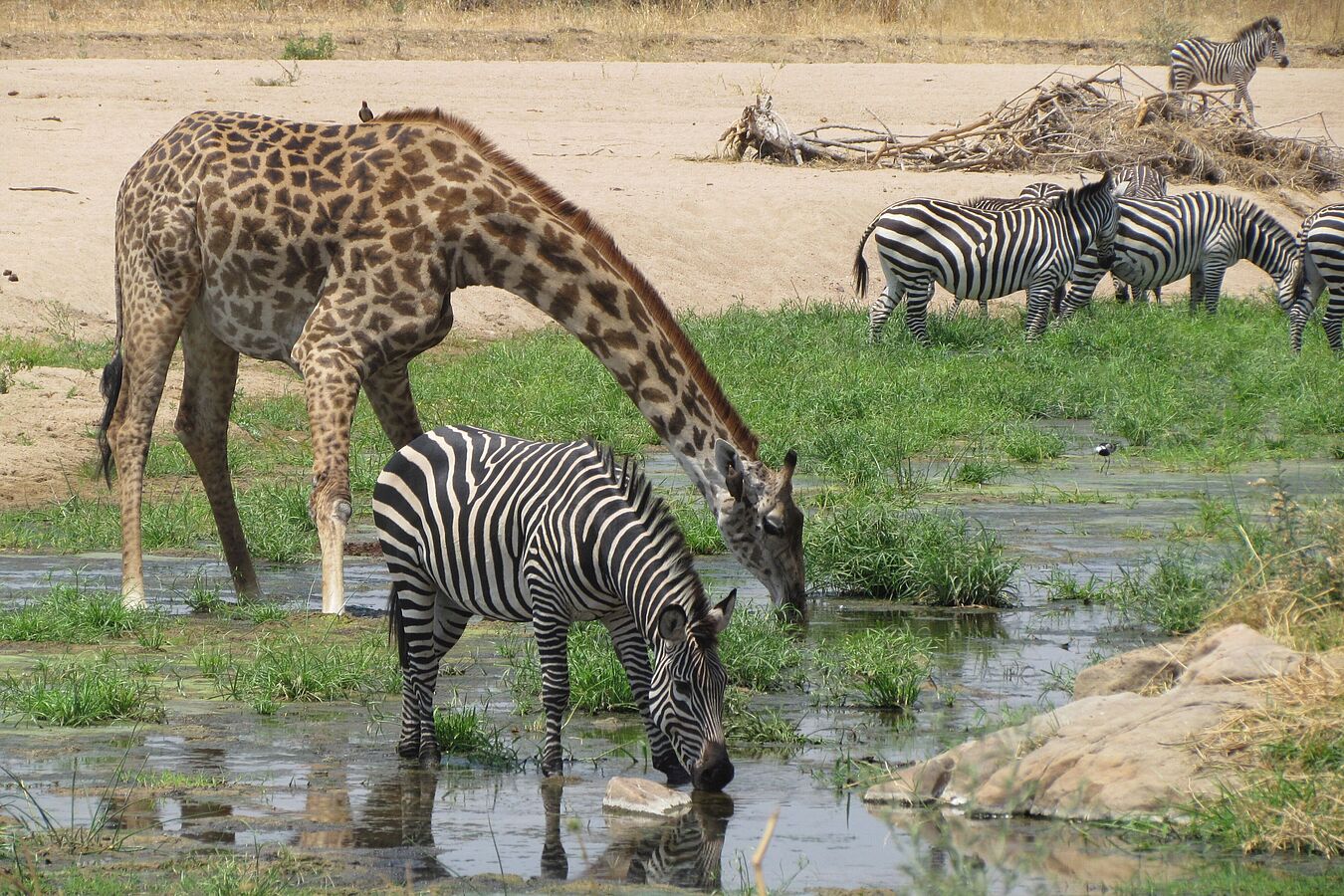Climate change is not the only cause of arid landscapes: a research team led by the Leibniz Institute for Zoo and Wildlife Research (Leibniz-IZW) has investigated the consequences of increased water abstraction for agriculture and livestock farming from the Great Ruaha River.

Zebras and giraffes drinking in Ruaha National ParK | Photo: Claudia Schmied
This river, which used to flow continuously, now dries up for months at a time. The scientists showed that some herbivores were able to partially compensate for the temporary lack of water through their diet, whereas others have little or no ability to do so. In particular, African buffalo, plains zebra and waterbuck were sometimes severely restricted in their habitat use as a result. The effects of water scarcity on Ruaha National Park's biodiversity are described in an article in the scientific journal "Wildlife Biology".
Although national parks across Africa aim to protect wildlife from the direct negative impacts of human activities such as bushmeat hunting, poaching and livestock farming, wildlife populations are declining in many national parks. This is partly due to indirect human impacts, such as water abstraction from rivers outside national parks. When little or no rain falls during the dry season in African countries, temporary water sources such as puddles, rain-filled depressions and pools dry up. Many animal species respond by moving to the area around the remaining water.
"We wanted to find out which animal species cope best with water scarcity and which survival strategies they develop," explains first author Dr Claudia Schmied, whose doctoral thesis on the consequences of water abstraction from the Great Ruaha River for the large animal community was supervised by the Leibniz-IZW. "During three dry seasons, we investigated which herbivores in Ruaha National Park changed their location and moved to sites where they find reliable water sources."
Some herbivores were more sensitive to water shortages than others, the scientists confirm. "There are animals that can partially compensate for the lack of drinking water through their diet, or have mechanisms to regulate their body temperature to limit water loss through faeces and urine. Our results show that omnivores such as the crowned duiker and the warthog staid put, so that their distance to the nearest water source in the late dry season significantly increased, so they did not follow the water," says Schmied. This was also the case for impala (Aepyceros melampus) and greater kudu (Strepsiceros zambesiensis) which have a mixed vegetarian diet. "Our results suggest that these species are better able to cope with the decline in surface water than, for example, the African buffalo." As grazers, African buffalo (Syncerus caffer), plains zebra (Equus quagga) and waterbuck (Kobus ellipsiprymnus) need constant access to drinking water. Omnivores such as the warthog (Phacochoerus africanus) and the crown duiker (Sylvicapra grimmia) have a broader diet, eating underground plants such as tubers and rhizomes, fruits and smaller animals - food that contains more water than the grass during the dry season. This advantage makes these species less dependent on access to drinking water.
The scientists mapped where the animals went in the early and late parts of the dry seasons to record in which locations they spent their time. The results were consistent with the expectation that some species were moving closer to the few remaining water sources in the upper Great Ruaha River. "Our spatial analyses showed that the African buffalo completely withdrew from the study area during the dry season. These grazing animals are particularly dependent on water, as the moisture content of the grazed grasses is low during the dry season," says Professor Stephanie Kramer-Schadt, head of the Department of Ecological Dynamics at the Leibniz-IZW. "The African buffalo in Ruaha National Park therefore loses large parts of its habitat during the dry season," adds Dr Marion East, scientist in the Department of Ecological Dynamics at the Leibniz-IZW and supervisor of Schmied's doctoral work.
At the end of the dry season, water-dependent herbivores increasingly congregated around the shrinking waterholes on the upper reaches of the Great Ruaha River. Larger predators such as lions and leopards move into these areas and consume a part of these populations. However, little is known about the long-term effects of the loss of water from the Great Ruaha River on the ecology of Ruaha National Park and its high biodiversity. Increasing concentrations of animals around remaining water sources may facilitate the transmission of pathogens, the scientists suggest. The high levels of water loss could also lead to a more rapid decline in nutrient quality and riparian vegetation, which in turn could affect the health of herbivores and have negative consequences for their populations.
Ruaha National Park in Tanzania was established in 1964 and expanded in 2008 to include Usangu Game Reserve. Covering an area of 20,226 square kilometres, it is one of the largest national parks in Africa. It is considered to be one of the most important wildlife habitats in Africa. The Great Ruaha River is one of Tanzania's largest rivers and regarded as the ecological backbone of Tanzania, before it flows through Ruaha National Park (Tanzania), one of Africa's largest national parks.
Schmied C, Hofer H, Scherer C, Kramer-Schadt S, East ML (2024):
Wildlife Biology 2024: e01131. DOI: 10.1002/wlb3.01131






